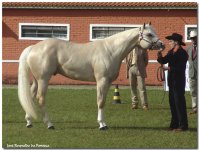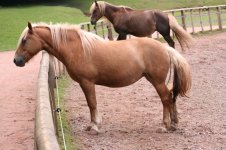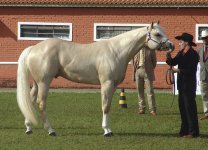♘امیرحسین♞
♘ مدیریت انجمن اسب ایران ♞
Palomino طلایی
Palomino is a coat color in horses, consisting of a gold coat and white mane and tail. Genetically, the palomino color is created by a single allele of a dilution gene called the cream gene working on a red (chestnut) base coat. However, most color breed registries that record Palomino horses were founded before equine coat color genetics were understood as well as they are today, and hence the standard definition of a Palomino is based on the coat color visible to the eye, not the underlying presence of the dilution gene.
While the breed standard states the ideal color is that of a "newly minted gold coin" (sometimes mistakenly claimed to be a penny), some Palomino registries allow a coat color that may range from cremello, an almost-white color, to a deep, dark, chocolate color ("chocolate palomino"). Skin and eyes are usually dark, though some foals are born with light-colored eyes that darken as the horse ages. White markings are permitted on the legs, but must not extend beyond the knees or hocks. White markings are also permitted on the face, but must not extend past the eyes.
Colors that are not true Palomino
Many non-palominos have a gold coat or a light mane, or both. Horses that have a gold body but a black mane and tail are Buckskins. Those that have a dull gold or tan body with a dark mane and tail plus "primitive" dark markings such as a dorsal stripe down the spine and zebra markings on the back of the forearms are called duns. Horses with a chocolate-colored coat with a light mane and tail may actually be black horses expressing the silver dapple gene. Many reddish-colored "palominos" with a light cream mane and tail are chestnut horses that carry a flaxen gene. The Champagne gene also causes a golden-colored coat on some horses, but the presence of pink skin, blue eyes in adulthood, and mottled skin suggest the presence of the champagne gene, not the cream gene.
Color breed
The Palomino is considered a color breed. Unlike the Appaloosa, which is a distinct breed that also happens to have a unique color, any breed or type of horse usually may be registered as palomino if they are properly golden-colored (though, for some registries, horses may also meet a conformation or type standard). The palomino cannot be a true breed, however, because palomino color is an incomplete dominant gene and does not breed "true;" A palomino crossed with a palomino may result in a palomino about 50% of the time, but could also produce a chestnut (25% probability) or a cremello (25% probability). Thus, palomino is simply a color alleleand not a set of characteristics that make up a "breed."
Because registration is based solely on coat color, horses from many breeds or combination of breeds may qualify. Some breeds that have palomino representatives are the American Saddlebred, Tennessee Walking Horse, Morgan and Quarter Horse. The color is fairly rare in the Thoroughbred, but does in fact occur and is recognized by The Jockey Club. Some breeds, such as the Haflinger and Arabian, may appear to be palomino, but are genetically chestnuts with flaxen manes and tails, as neither breed carries the cream dilution. However, in spite of their lack of correct DNA, some Palomino color registries have registered such horses if their coat color falls within the acceptable range of shades.
While the breed standard states the ideal color is that of a "newly minted gold coin" (sometimes mistakenly claimed to be a penny), some Palomino registries allow a coat color that may range from cremello, an almost-white color, to a deep, dark, chocolate color ("chocolate palomino"). Skin and eyes are usually dark, though some foals are born with light-colored eyes that darken as the horse ages. White markings are permitted on the legs, but must not extend beyond the knees or hocks. White markings are also permitted on the face, but must not extend past the eyes.
Colors that are not true Palomino
Many non-palominos have a gold coat or a light mane, or both. Horses that have a gold body but a black mane and tail are Buckskins. Those that have a dull gold or tan body with a dark mane and tail plus "primitive" dark markings such as a dorsal stripe down the spine and zebra markings on the back of the forearms are called duns. Horses with a chocolate-colored coat with a light mane and tail may actually be black horses expressing the silver dapple gene. Many reddish-colored "palominos" with a light cream mane and tail are chestnut horses that carry a flaxen gene. The Champagne gene also causes a golden-colored coat on some horses, but the presence of pink skin, blue eyes in adulthood, and mottled skin suggest the presence of the champagne gene, not the cream gene.
Color breed
The Palomino is considered a color breed. Unlike the Appaloosa, which is a distinct breed that also happens to have a unique color, any breed or type of horse usually may be registered as palomino if they are properly golden-colored (though, for some registries, horses may also meet a conformation or type standard). The palomino cannot be a true breed, however, because palomino color is an incomplete dominant gene and does not breed "true;" A palomino crossed with a palomino may result in a palomino about 50% of the time, but could also produce a chestnut (25% probability) or a cremello (25% probability). Thus, palomino is simply a color alleleand not a set of characteristics that make up a "breed."
Because registration is based solely on coat color, horses from many breeds or combination of breeds may qualify. Some breeds that have palomino representatives are the American Saddlebred, Tennessee Walking Horse, Morgan and Quarter Horse. The color is fairly rare in the Thoroughbred, but does in fact occur and is recognized by The Jockey Club. Some breeds, such as the Haflinger and Arabian, may appear to be palomino, but are genetically chestnuts with flaxen manes and tails, as neither breed carries the cream dilution. However, in spite of their lack of correct DNA, some Palomino color registries have registered such horses if their coat color falls within the acceptable range of shades.



